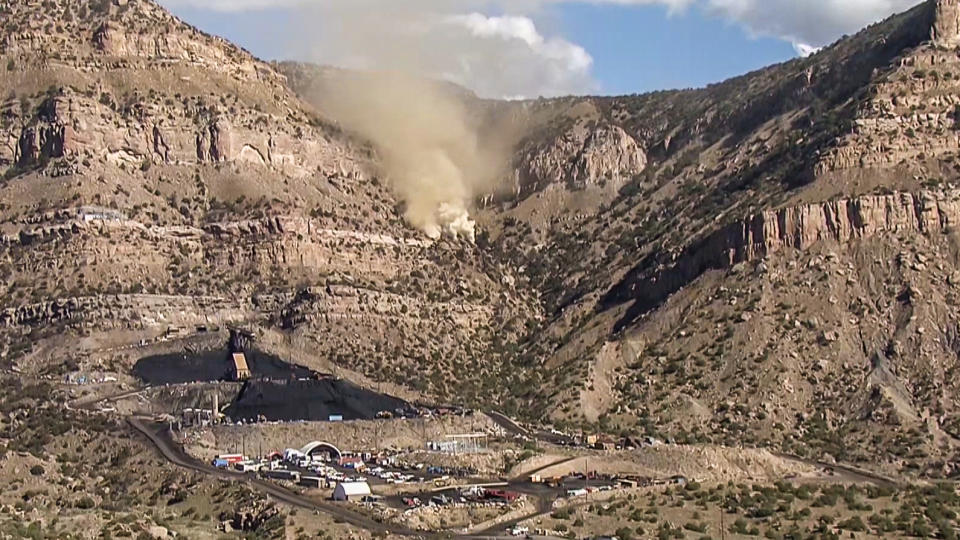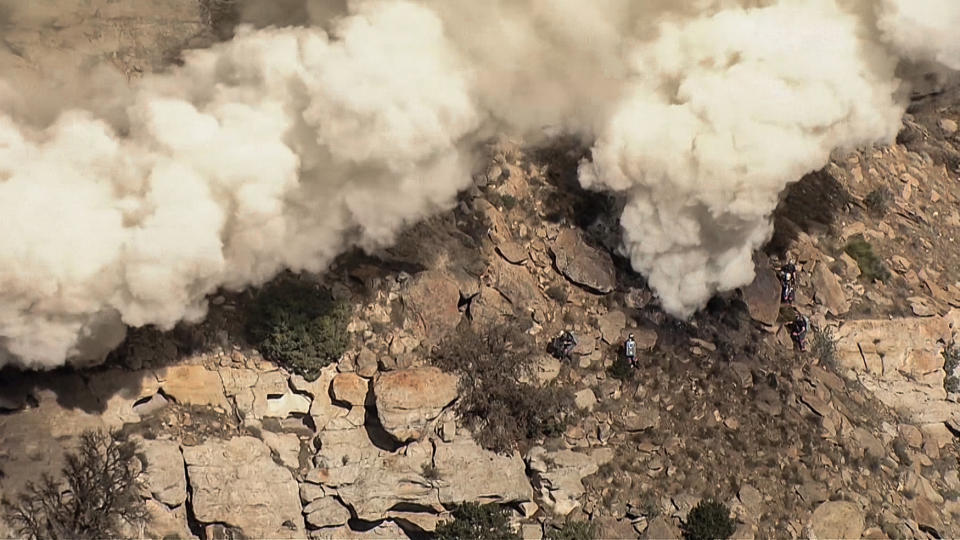A coal mine is on fire in Utah, leaving a small town at risk
In late September, an underground coal mine just outside the town of East Carbon in rural Utah caught fire. More than two months later, it’s still burning.
Now, the once-bustling mine called Lila Canyon faces permanent shuttering, which would leave its over 230 workers idled and result in gaps in raw materials for statewide energy production. The coal mine is one of the busiest in the state and produces about 28% of Utah’s coal.
For nearby residents to Lila Canyon, what happens next for the miners and the truck drivers who help deliver coal is up in the air. About a quarter of the residents in East Carbon are living in poverty, according to U.S. Census Bureau data.
“The younger people actually work in the mine and that’s their main source of income,” Janice Hunt, an East Carbon resident and former coal mine worker, said. “There could be big consequences, especially to our community. We’re already suffering as it is.”

It’s a situation that underscores the crucial but perilous role coal continues to play in some parts of the country. Even as the U.S. shifts away from coal production, plenty of small towns still rely on the risky and declining business, which makes up 21.9% of U.S. energy production, according to the U.S. Energy Information Administration.
The fire now threatens to permanently end what had been one of the places where coal was trying to make a comeback in recent years, most notably as the world looked for underappreciated energy sources following Russia’s invasion of Ukraine. Under the Trump administration, the mine received an extension of life when the Bureau of Land Management agreed to expand the mine. The Trump administration gave several towns relying on oil, gas and coal a boost by cutting royalty payments and expanding projects.
Legal documents show that the expansion is currently in limbo after the Sierra Club filed a legal complaint in June over BLM’s analysis of the environmental impacts of the mine expansion. BLM agreed to go back and review its analysis in November, about two months after the fire began.
Now the ongoing fire is affecting a community riddled with environmental issues and poverty.
“If I could leave tomorrow, I would,” Hunt said.
East Carbon is a coal town, one of only a few hundred still hanging on. Other towns where coal mines have already shuttered continue to figure out a way forward. But some struggle to reinvent themselves, sometimes even becoming ghost towns.
Even though the number of coal miners in the town has dwindled over the years, East Carbon is marked by the coal industry that once thrived there — the city itself is an incorporation of several past struggling mining towns. On the far east edge sits a trading post called Miners, and its main attraction is the ruins of coke ovens, which are large brick ovens where coal was converted into a fuel for steel production.
Emery County Coal Resources, which is a subsidiary of American Consolidated Natural Resources, owns Lila Canyon Mine and did not reply to several requests for comment. How the fire was discovered, progress on putting it out and what will happen to the hundreds of workers employed by the company going forward are still unknown. Local officials say the fire is believed to have been caused by spontaneous combustion, which isn’t unusual for a coal mine fire.
Such fires are tricky and difficult to extinguish. They’ve happened all across the country, and they can last anywhere from a few days to a few years. Some have even been burning for decades, including one notable coal mine fire in 1962 in Centralia, Pennsylvania, which cleared out the town due to the closure of the mine and toxic fumes being released.
Utah relies heavily on coal for energy: 61% of the state’s electricity net generation came from coal-fired plants. It’s a historic low for the state, but still puts it in the top half of the country for coal consumption. Over the years, coal mines across the state have declined, just as they have across the country.
About 40% of the coal produced from Lila Canyon goes to two major power plants in Utah run by the company PacifiCorp. The company said electricity will not be disrupted, but the impacts of the mine fire on the plants have not yet been assessed.
“It can be challenging to get rid of coal fires,” said Lance Porter, the Green River district manager for the Bureau of Land Management. But Porter said Emery County Coal Resources, the company that runs the mine, has a solid plan to extinguish it.

When the fire began, the company sealed several access points and vents to limit oxygen getting into the mine. Porter said the Bureau of Land Management has signed off on a plan that allows them to drill 35 boreholes in order to assess the fire. The drilling will likely take months due to winter weather conditions. From there, they’ll flood the mine with water through a temporary pipeline.
Although Porter is hopeful, the plan does not guarantee the fire will stop burning. Porter didn’t comment on whether there was an environmental threat to local communities, but he did say the vents have been sealed, and Emery County Coal Resources will be using the boreholes to test the air quality of the mines. The Mine Safety and Health Administration will have to evaluate the findings from the tests and deem it safe before the company can bring miners back in.
Trent Garrison, an assistant professor at Jefferson Community and Technical College in Kentucky who studies coal mine fires, said these fires are often hard to detect and defuse. They smolder underground and will continue to burn as long as there is fuel, in this case coal, to keep it going and a little oxygen.
Cracks and openings in the ground allow oxygen to seep in, powering the blaze. Some of the openings can be sealed, like they were in this case, but it’s nearly impossible to close every access point, Garrison said.
“Some coal fires have been burning for over 1,000 years, and there’s just nothing you can do,” Garrison said.
In the early days of the fire, smoke was pouring from the mine. An environmental assessment found hazardous gases were being emitted. Some residents nearby said they noticed the smoke.
Local officials and residents say there is no longer active smoke in the area. But it doesn’t erase the possibility of gases escaping the vents.
Garrison said his research team would have to wear professionally fitted respirators before getting near coal fire areas.
“Once you smell a coal fire … you’ll never forget it,” he said. “It’s awful. I mean, it is the worst thing ever. And you can just tell if you’re in that environment, you shouldn’t be there long because it’s probably not doing your body any good.”
“It’s kind of a mix between like rotten eggs and burning tires,” he added.
This article was originally published on NBCNews.com

